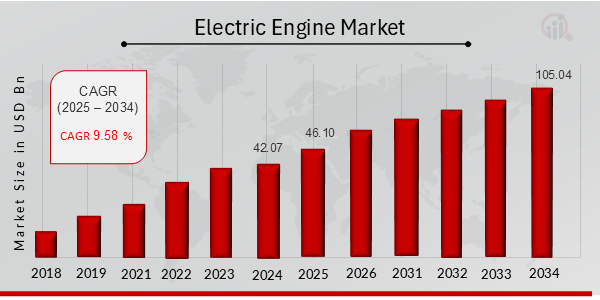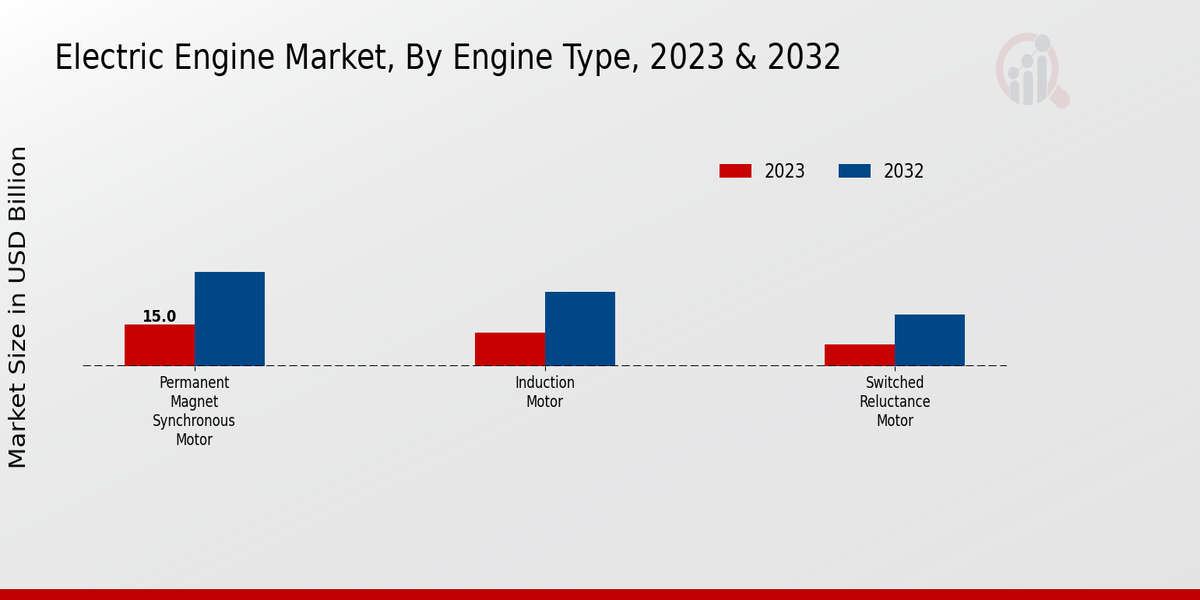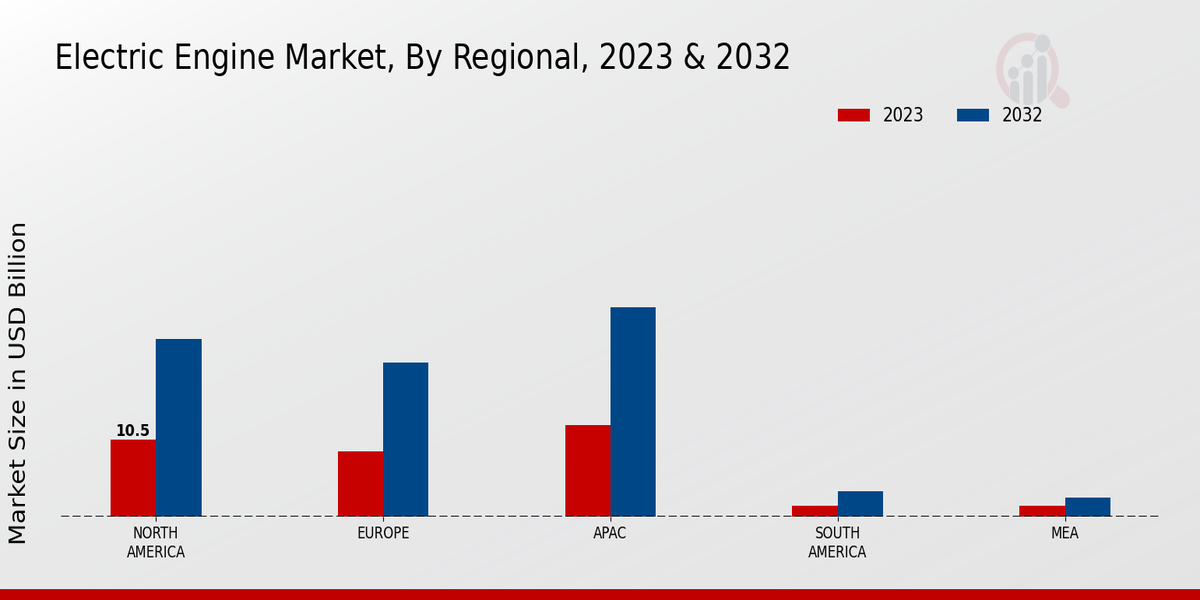Global Electric Engine Market Overview
As per MRFR analysis, the Electric Engine Market Size was estimated at 42.07 (USD Billion) in 2024. The Electric Engine Market Industry is expected to grow from 46.10 (USD Billion) in 2025 to 105.04 (USD Billion) till 2034, at a CAGR (growth rate) is expected to be around 9.58% during the forecast period (2025 - 2034).
Key Electric Engine Market Trends Highlighted
The Electric Engine Market is driven by several key factors, including the increasing focus on reducing carbon emissions and the growing demand for energy-efficient solutions. As governments and organizations push for greener alternatives, electric engines have gained traction in various sectors, particularly transportation and industrial applications.
The shift toward renewable energy sources has also provided a significant boost as electric engines become more compatible with solar, wind, and other sustainable energy forms. Additionally, advancements in technology have made electric engines more cost-effective and reliable, further encouraging their adoption.
Opportunities within the market are vast, especially in emerging economies where the industrial base is expanding. There is a growing interest in electric engines for public transportation, such as buses and trains, which presents a chance for businesses to innovate and diversify.
Moreover, the rise of electric vehicles offers an additional avenue for growth, driving demand for electric engines that are efficient and high performing. Companies can explore partnerships with technology firms to enhance engine design and functionality, creating synergies that lead to better products that meet evolving consumer needs.
In recent times, trends such as increased investment in electric mobility and the development of smart grid technology have significantly influenced the market landscape. Collaborative efforts across industries have led to new technologies that further enhance the performance of electric engines.
The trend towards urbanization also encourages the adoption of electric engines in last-mile delivery services, making them a focal point in cities aiming to reduce traffic congestion and pollution. As the market continues to evolve, the opportunities and innovations driven by these trends point to a promising future for the Electric Engine Market.

Source: Primary Research, Secondary Research, MRFR Database and Analyst Review
Electric Engine Market Drivers
Increasing Environmental Concerns and Regulatory Support
As global awareness of climate change and environmental sustainability grows, the demand for cleaner and more efficient energy sources has become a significant driver in the Electric Engine Market. Governments and regulatory bodies are implementing stringent emission norms and incentivizing the adoption of electric vehicles (EVs), as well as promoting electric engine technologies.
The transition from traditional fossil fuel-based engines to electric engines is supported by various international agreements aimed at reducing carbon footprints and promoting green energy solutions. This shift is not just a response to regulatory pressures but is also driven by consumer demand for sustainable transportation options.
The increasing availability of charging infrastructure, coupled with technological advancements in battery efficiency, makes electric engines more viable and attractive to consumers and businesses alike. Moreover, the competitive pricing of electric engines compared to internal combustion engines continues to improve, further bolstering their market presence.
The Electric Engine Market is expected to thrive in this context as electric engines become increasingly integrated into various sectors, including automotive, aerospace, and marine, driven by both environmental necessity and the pursuit of innovation.
Technological Advancements in Electric Engine Design
Rapid technological advancements in electric engines are revolutionizing the Electric Engine Market, making these systems more efficient and appealing for various applications.
Innovations such as improved battery technologies, electric motor designs, and power electronics are enhancing the performance and range of electric engines. As research and development continue in areas like solid-state batteries and energy management systems, electric engines are becoming more powerful while maintaining a compact size and lower weight.
These advancements not only improve the efficiency of electric engines but also reduce costs associated with manufacturing, leading to wider adoption in both consumer and industrial markets. Electric engine technologies are progressing at an unprecedented rate, positively influencing market growth.
Growing Consumer Demand for Electric Vehicles
With increased consumer awareness regarding the environmental impact of traditional vehicles, the demand for electric vehicles (EVs) has escalated significantly. The Electric Engine Market is experiencing a shift where consumers preferring electric options due to their lower operating costs, reduced environmental impact, and the overall trend towards sustainable living.
This consumer behavior is further fueled by the rising availability of EV models, enhanced charging infrastructure, and technological improvements that offer longer driving ranges. As manufacturers focus on meeting this growing demand, it leads to increased investments in the development of electric engines, consequently promoting overall market growth.
Electric Engine Market Segment Insights:
Electric Engine Market Engine Type Insights
The Electric Engine Market is diversely segmented by Engine Type, showcasing significant growth dynamics and market potential. Among the prominent players in this segment, the Permanent Magnet Synchronous Motor (PMSM) held a majority share, valued at 15.0 USD Billion in 2023 and is expected to grow to 34.0 USD Billion by 2032.
This engine type benefits from its high efficiency and superior torque characteristics, making it ideal for various applications, including electric vehicles and industrial machinery, thus allowing it to dominate the market significantly.
Following closely was the Induction Motor, which was valued at 12.0 USD Billion in 2023, with a projected increase to 27.0 USD Billion by 2032. Induction motors are renowned for their robustness and lower manufacturing costs, making them a practical choice in many sectors and contributing to their strong market presence.
Lastly, the Switched Reluctance Motor, valued at 8.04 USD Billion in 2023, is forecasted to reach 18.8 USD Billion in 2032; it represents a growing option within the market due to its simple design and affordability, though it remains less dominant compared to the PMSM and Induction Motor.
The different performance characteristics, efficiency levels, and cost implications of these motors provide valuable insights, showcasing a diverse landscape within the Electric Engine Market, which is driven by the increasing demand for energy-efficient electric solutions across various industries.
The market is also experiencing significant growth opportunities fueled by technological advancements and rising environmental concerns, causing industries to shift towards electric alternatives. However, the competition among the engine types continues to evolve as manufacturers strive to enhance performance and reduce costs, creating a dynamic environment within the Electric Engine Market segmentation.
The statistics for this market highlight the growing importance and opportunities presented by each engine type, showcasing a robust growth trajectory driven by industrial applications and innovations in electric drive technologies.

Source: Primary Research, Secondary Research, MRFR Database and Analyst Review
Electric Engine Market Power Output Insights
Power Output plays a critical role in this market, as it is divided into categories such as Below 50 kW, 50 kW to 150 kW, and Above 150 kW. Each category caters to varying application needs, making them essential for different sectors, including automotive, aerospace, and industrial.
Below 50 kW is significant due to its prevalence in small-scale electric vehicles and devices. Meanwhile, the 50 kW to 150 kW range finds application in medium-duty electric vehicles, where efficiency and performance are crucial.
Above 150 kW, this segment is dominated by heavy-duty electric engines used in commercial vehicles and machinery, reflecting a shift towards sustainable energy solutions in industries. The Electric Engine Market statistics indicate increasing demand driven by the push for electrification and environmental regulations, spurring technological advancements and competitive innovations.
Overall, the market growth is fueled by a mix of governmental support, rising energy costs, and evolving consumer preferences toward cleaner energy alternatives.
Electric Engine Market Cooling System Insights
The market plays a crucial role in enhancing the efficiency and longevity of electric engines. As the preference for electric vehicles and renewable energy sources rises, effective cooling solutions become paramount.
Within this segment, the methodologies of cooling are diverse, including Air Cooled, Liquid Cooled, and Hybrid Cooling systems, each serving essential roles. Air-cooled systems offer simplicity and lower costs, making them a favorable choice in many situations, while liquid-cooled systems dominate due to their superior heat management and efficiency in high-performance engines.
Hybrid Cooling, which combines elements of both, is emerging as a significant player due to its adaptability and effectiveness in varying operational conditions. The ongoing advancements in cooling technologies are driven by the growing demand for electric vehicles, creating substantial opportunities for innovation and investment.
The Electric Engine Market statistics highlight a robust market growth trajectory largely fueled by increasing environmental regulations and consumer acceptance of electric mobility solutions, paving the way for a sustainable future.
Electric Engine Market End Use Insights
The segmentation of this market by End Use highlights the significance of Automotive, Aerospace, and Industrial applications, which play pivotal roles in shaping the market's landscape. The Automotive sector, in particular, stands out as a major contributor due to rising consumer preference for electric vehicles, spurred by environmental concerns and stricter emissions regulations.
In the Aerospace sector, electric engines are gaining traction for their potential to enhance fuel efficiency and reduce carbon footprints, reflecting the industry's shift towards sustainable practices. Meanwhile, the Industrial segment is also expanding rapidly, influenced by automation and the need for efficient energy solutions in manufacturing processes.
Each of these segments contributes uniquely to the Electric Engine Market revenue, supported by trends such as technological advancements and the global transition towards renewable energy. The overall Electric Engine Market statistics reflect a robust trajectory, with significant opportunities for innovation and market expansion across these critical industries.
Electric Engine Market Regional Insights
The Electric Engine Market is poised for substantial growth, with regional analysis revealing distinct valuation insights. In 2023, the market in North America was valued at 10.5 USD Billion, reflecting its significant role in the overall industry.
Europe closely followed with a valuation of 9.0 USD Billion, indicating a strong commitment to electric engine technology. Asia-Pacific (APAC) took the lead with the highest valuation of 12.5 USD Billion, showcasing the region's major hold on production and consumption driven by increasing demand for sustainable transportation solutions.
South America and Middle East Africa (MEA) contributed more modestly, each valued at 1.5 USD Billion in 2023, pointing towards emerging opportunities in these developing regions. The expectations for these regional markets emphasize the shifting dynamics towards electric alternatives, influenced by government policies, technological advancements, and growing environmental concerns.
The majority holding of APAC in the Electric Engine Market revenue underlines its importance as a manufacturing hub, while North America's advanced infrastructure supports its growth prospects. This segmentation highlights the diverse landscape, showcasing opportunities and challenges each region faces as it adapts to the evolving electric engine market landscape.

Source: Primary Research, Secondary Research, MRFR Database and Analyst Review
Electric Engine Market Key Players and Competitive Insights:
The Electric Engine Market has witnessed significant competitive dynamics over the years, primarily driven by advancements in technology, environmental regulations, and a growing consumer demand for sustainable transportation solutions.
Various players in the market are competing not only on the basis of innovation and product development but also regarding their ability to establish partnerships and collaborations that can enhance their market position.
The transition towards electric engines has revolutionized the automotive landscape, with companies investing substantially in research and development to create more efficient, reliable, and eco-friendly electric propulsion systems. This competition is characterized by a focus on reducing costs, enhancing performance, and meeting regulatory standards, which are critical to gaining a competitive edge.
Toyota has established a commendable presence in the Electric Engine Market, highlighted by its commitment to hybrid and electric vehicle technology. The company has invested heavily in research and development, allowing it to leverage its expertise in battery production and electric motor design.
Strengths of Toyota include its well-established brand image, extensive experience in the automotive industry, and a comprehensive supply chain that facilitates efficient production processes. Toyota's approach to sustainability is embodied in its philosophy of continuous improvement, which drives innovation.
The company's strategic collaborations and partnerships with technology firms further enhance its capabilities, allowing it to stay ahead in a rapidly evolving market. Its diversified portfolio also allows it to cater to varying consumer preferences, making it a formidable player in the electric engine domain.
General Motors has strategically positioned itself within the Electric Engine Market by focusing on electric vehicle innovation and sustainability. The company has made substantial investments in developing new electric engine technologies and expanding its electric vehicle lineup.
General Motors has embraced an ambitious vision of an all-electric future, underscoring its commitment to sustainability and environmental responsibility. The strengths of General Motors lie in its robust research and development infrastructure and its ability to leverage its extensive distribution networks for effective market penetration.
By promoting a broader array of electric engine options, General Motors successfully addresses a diverse range of customer needs and preferences, ensuring its competitiveness in the rapidly growing electric vehicle segment.
This forward-thinking approach allows General Motors to compete effectively as it strives to integrate next-generation electric technologies into its vehicles while creating strong brand loyalty among consumers.
Key Companies in the Electric Engine Market Include:
Electric Engine Market Developments
The Electric Engine Market has recently witnessed significant advancements, particularly with automakers such as Toyota, General Motors, and Volkswagen ramping up their electric vehicle (EV) production capabilities.
Toyota has been focusing on expanding its EV lineup, while General Motors announced an investment in battery technology aimed at enhancing EV performance. Volkswagen continues to push forward with its electrification strategy, including plans to increase battery production. Meanwhile, GE Aviation is exploring electric propulsion systems for commercial aircraft, indicating an interest in sustainable aviation solutions.
In terms of mergers, Ford's acquisition of a battery technology firm is expected to bolster its electric powertrain capabilities, and Hyundai's collaboration with Hitachi aims to innovate in electric engine technology, fostering growth in this sector.
Additionally, Caterpillar and ABB are making strides in electrifying heavy machinery, which opens avenues for growth in industrial applications of electric engines. The market’s overall growth is reflected in increased valuations for these companies, driven by rising consumer demand for sustainable transportation options and innovations in battery technologies, setting a transformative trajectory for the industry.
Electric Engine Market Segmentation Insights
| Report Attribute/Metric |
Details |
|
Market Size 2024
|
42.07 (USD Billion)
|
|
Market Size 2025
|
46.10 (USD Billion)
|
|
Market Size 2034
|
105.04 (USD Billion)
|
|
Compound Annual Growth Rate (CAGR)
|
9.58% (2025 - 2034)
|
|
Report Coverage
|
Revenue Forecast, Competitive Landscape, Growth Factors, and Trends
|
|
Base Year
|
2024
|
|
Market Forecast Period
|
2025 - 2034
|
|
Historical Data
|
2019 - 2023
|
| Market Forecast Units |
USD Billion |
| Key Companies Profiled |
Toyota, General Motors, GE Aviation, Volkswagen, Hyundai, Hitachi, Nissan, Ford, Tesla, Caterpillar, ABB, Honda, Panasonic, Siemens, BMW |
| Segments Covered |
Engine Type, Power Output, Cooling System, End Use, Regional |
| Key Market Opportunities |
Rising demand for eco-friendly vehicles, Advancements in battery technology, Expansion of electric public transport, Government incentives for electric vehicles, Growth in the electric aviation sector |
| Key Market Dynamics |
growing demand for electric vehicles, advancements in battery technology, stringent emission regulations, increasing investment in renewable energy, government incentives for electric engines |
| Countries Covered |
North America, Europe, APAC, South America, MEA |
Frequently Asked Questions (FAQ) :
The Electric Engine Market is anticipated to reach a value of 105.04 USD Billion by 2034.
In 2024, the Electric Engine Market was valued at approximately 42.07 USD Billion.
The Electric Engine Market is projected to grow at a CAGR of 9.58% from 2025 to 2034.
North America is expected to have the largest market size at around 24.2 USD Billion by 2032.
The Permanent Magnet Synchronous Motor segment is projected to reach a market size of 34.0 USD Billion by 2032.
Major players in the Electric Engine Market include Toyota, General Motors, GE Aviation, Volkswagen, and Tesla.
The Asia-Pacific region's market for electric engines is expected to grow to approximately 28.6 USD Billion by 2032.
The market size for Induction Motors is expected to be around 27.0 USD Billion by 2032.
Key trends include increasing demand for energy-efficient solutions and advancements in electric vehicle technologies.
The Switched Reluctance Motor segment is expected to reach a size of 18.8 USD Billion by 2032.

















